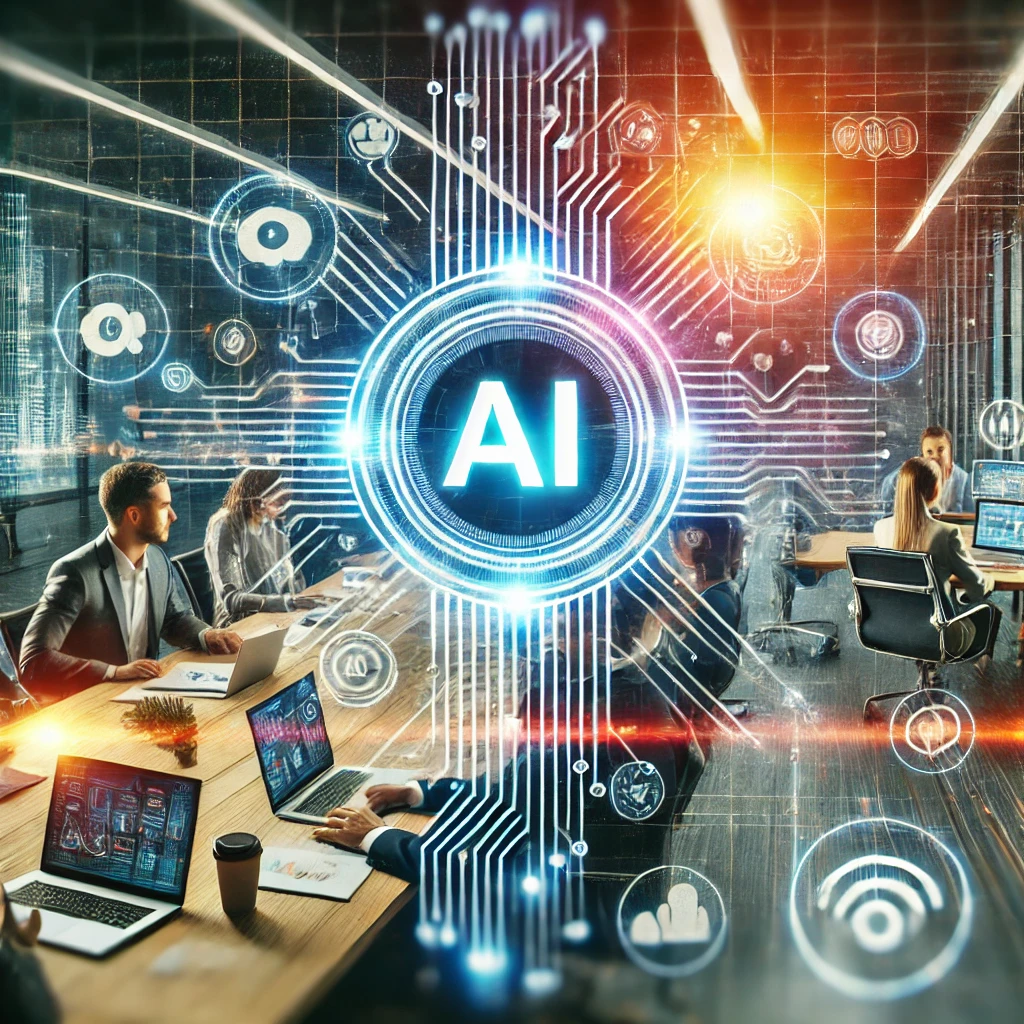In today’s rapidly evolving digital landscape, the integration of Artificial Intelligence (AI) within business blueprints has emerged as a transformative force, reshaping traditional business models and driving unprecedented levels of efficiency and profitability. Companies across industries are leveraging the AI advantage to refine their strategies, streamline operations, and position themselves as leaders in an increasingly competitive market. This article delves into how AI-powered business blueprints are changing the future of business, providing insights into AI-driven strategies, real-world applications, and best practices for maximizing the impact of AI on business performance.
The Importance of an AI-Powered Business Blueprint
The concept of a business blueprint revolves around a strategic plan or framework that guides a company’s operations, growth, and long-term goals. Traditional blueprints are often static, but the integration of AI has introduced a dynamic element, allowing for real-time data processing, predictive analytics, and automated decision-making. These capabilities grant businesses agility and precision, transforming the way they approach market trends, customer interactions, and operational efficiency.
AI in business blueprints acts as a foundation for organizations aiming to harness data-driven insights, improve customer experiences, and achieve competitive advantages. AI-powered frameworks are designed to evolve continuously, adapting to changes in the business environment and providing actionable intelligence to fuel growth and innovation.

Key Advantages of AI in Business Blueprints
-
Enhanced Decision-Making with Data-Driven Insights
AI enables businesses to process vast amounts of data at high speed, turning raw data into meaningful insights. Through machine learning algorithms and predictive analytics, AI identifies patterns, trends, and potential outcomes that guide decision-makers in crafting more effective strategies. By removing the guesswork, AI-driven insights enable companies to make informed choices, mitigate risks, and capitalize on emerging opportunities.
-
Improved Operational Efficiency through Automation
Automation is one of the most powerful benefits AI brings to business blueprints. From customer service to logistics, AI automates repetitive tasks, allowing human resources to focus on higher-value work. This not only reduces operational costs but also accelerates workflows, minimizes human error, and increases productivity across departments. For instance, chatbots provide instant customer service responses, while AI-powered supply chain management ensures that inventory levels are optimized and delivery times are shortened.
-
Personalized Customer Experiences
AI-driven business blueprints empower organizations to deliver personalized customer experiences at scale. By analyzing customer behavior, preferences, and purchasing history, AI can help businesses tailor their offerings to individual needs, increasing customer satisfaction and loyalty. E-commerce platforms, for example, use AI algorithms to recommend products based on previous purchases, while customer service chatbots offer customized solutions and responses, enhancing user engagement.
-
Cost Savings and Increased Revenue Generation
The cost-saving potential of AI stems from its ability to optimize resources and minimize waste. With predictive analytics, businesses can accurately forecast demand, reducing inventory costs and avoiding overproduction. In addition, AI-driven marketing automation helps in identifying the most profitable customer segments, enabling targeted campaigns that yield a higher return on investment (ROI). Consequently, AI-powered blueprints support sustainable growth by maximizing revenue generation while minimizing overhead costs.
-
Scalability and Flexibility
Unlike traditional blueprints, AI-powered business frameworks are inherently scalable and flexible. As companies grow, AI systems adapt, processing larger data volumes and evolving in complexity to support more extensive operations. This adaptability allows businesses to pivot quickly in response to market changes, ensuring resilience and competitiveness in a dynamic environment. Startups and small businesses especially benefit from scalable AI solutions, allowing them to compete with larger companies without the need for extensive infrastructure.
Real-World Applications of AI in Business Blueprints
The transformative power of AI is evident in numerous industries, where it has become integral to reshaping business processes and enhancing strategic outcomes. Below are some notable applications of AI across different sectors:
-
Retail and E-commerce
In the retail sector, AI is redefining customer engagement and inventory management. Personalized recommendation engines, powered by AI, analyze consumer preferences to suggest products, while predictive analytics helps in managing stock levels. Additionally, visual search capabilities enable customers to find products based on images, further enhancing their shopping experience.
-
Healthcare
AI is making waves in healthcare by improving diagnostics, patient care, and resource management. AI-powered business blueprints in healthcare help hospitals optimize scheduling, predict patient needs, and allocate resources effectively. Additionally, AI assists in drug discovery, identifying potential treatments faster and more accurately. These applications demonstrate how AI can enhance patient outcomes while reducing operational costs.
-
Finance and Banking
Financial institutions utilize AI to automate risk assessment, fraud detection, and customer service. AI algorithms analyze financial data to detect suspicious transactions, protecting customers and institutions from fraud. Moreover, robo-advisors provide personalized financial advice based on user profiles and goals, allowing for more accessible financial planning.
-
Manufacturing
In manufacturing, AI-driven business blueprints focus on process optimization, predictive maintenance, and quality control. AI-powered sensors monitor machinery to predict and prevent failures, reducing downtime and maintenance costs. Additionally, AI-based quality control systems analyze products in real-time, ensuring they meet quality standards and minimizing waste.
-
Logistics and Supply Chain
AI optimizes the supply chain by predicting demand, managing inventory, and improving logistics planning. With real-time data on traffic, weather, and other variables, AI algorithms enable efficient route planning and delivery schedules, reducing shipping times and costs. This level of optimization is invaluable for e-commerce companies and manufacturers that rely on timely deliveries and minimal inventory levels.
Key Components of an Effective AI-Powered Business Blueprint
For businesses looking to capitalize on AI, an effective blueprint should be grounded in specific, actionable components that align with organizational goals and industry standards.
-
Clear Objectives and KPIs
Start by defining the objectives you aim to achieve with AI. Establish Key Performance Indicators (KPIs) that align with these goals, whether they involve cost reduction, customer satisfaction, or operational efficiency. Clear objectives provide a roadmap, ensuring that AI implementations are focused and measurable.
-
Data Infrastructure
A robust data infrastructure is essential for AI to function effectively. Invest in secure data storage, processing, and management systems that facilitate real-time data flow. Structured and clean data is the foundation for accurate AI insights, while compliance with data privacy regulations builds trust and ensures ethical AI use.
-
Human-AI Collaboration
Successful AI integration involves balancing automation with human input. AI should augment human expertise, not replace it. Design workflows that allow employees to leverage AI insights and focus on strategic tasks, ensuring that AI-driven decisions are aligned with human intuition and experience.
-
Continuous Training and Optimization
AI is not a set-it-and-forget-it solution. Regularly train algorithms with updated data to improve accuracy and relevance. Continuously monitor performance, gather feedback, and make adjustments as needed to maximize the AI system’s impact.
-
Cybersecurity and Compliance
AI systems often handle sensitive data, making cybersecurity crucial. Implement rigorous security protocols to protect data integrity and comply with industry regulations. This fosters a secure environment, building trust with customers and stakeholders.
Best Practices for Maximizing AI Impact in Business Blueprints
To fully realize the potential of AI, companies should adopt best practices that facilitate seamless integration and sustainable outcomes.
-
Adopt a Phased Approach
Implementing AI across an organization can be overwhelming. A phased approach allows businesses to test AI in specific departments, gather results, and expand gradually. Starting with pilot projects minimizes risk and provides valuable insights into scaling up.
-
Invest in Employee Training
AI requires employees to learn new skills and adapt to digital workflows. Invest in training programs that equip your workforce with the necessary skills to work alongside AI technologies. A knowledgeable workforce enhances AI adoption, creating a culture of innovation.
-
Prioritize Ethics and Transparency
AI must be used ethically, especially when dealing with customer data. Prioritize transparency by explaining how AI is used and ensuring compliance with data privacy laws. Ethical AI use builds customer trust and avoids potential legal issues.
-
Utilize Feedback Loops
Encourage employees to provide feedback on AI systems and identify areas for improvement. Regularly assess the AI system’s performance against established KPIs and make adjustments based on feedback, ensuring that AI remains aligned with business goals.
Challenges and Considerations in Implementing AI Business Blueprints

Despite the transformative potential of AI, several challenges exist:
-
High Initial Costs
Implementing AI requires a significant upfront investment in technology, infrastructure, and training. Businesses must weigh the initial costs against long-term benefits to determine the feasibility of AI adoption.
-
Data Privacy and Security
With AI systems handling sensitive data, data privacy and security are paramount. Companies must ensure that AI complies with privacy regulations, safeguarding customer information and avoiding potential breaches.
-
Integration with Existing Systems
Integrating AI with legacy systems can be challenging. Companies need to ensure that new AI solutions are compatible with existing processes, which may require adjustments to the IT infrastructure.
-
Talent Shortages
AI expertise is in high demand, leading to a shortage of skilled professionals. Companies may struggle to find qualified personnel, making it essential to invest in internal training and upskilling.
The Future of AI in Business Blueprints
As AI continues to evolve, its role in business blueprints will expand, enabling organizations to remain competitive and resilient. Future AI developments, including natural language processing and machine learning, will make business processes even more intuitive and accessible, democratizing AI for businesses of all sizes. Additionally, AI ethics and regulation will become more prominent, emphasizing the need for transparent and responsible AI usage.
Conclusion
The AI advantage in business blueprints offers unparalleled opportunities for innovation, efficiency, and competitive edge. By incorporating AI into their blueprints, businesses can transform traditional practices, achieve greater operational agility, and respond proactively to market changes. While challenges remain, a thoughtful approach to AI implementation—grounded in clear objectives, ethical use, and continuous optimization—enables businesses to harness AI’s full potential. As AI technology advances, companies that embrace an AI-driven blueprint will lead the way in defining the future of business.











Leave a Reply